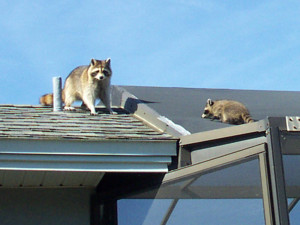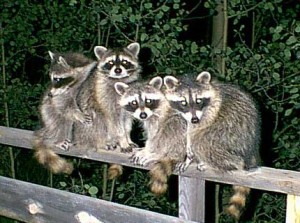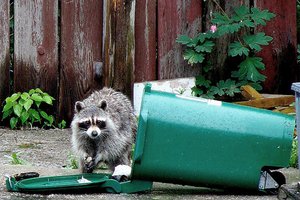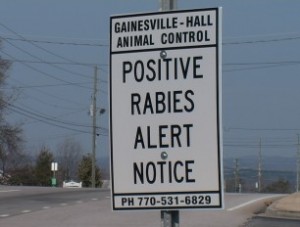 We recently found that raccoons had invaded our attic above our living room. This was particularly troubling to us in that they made a lot of noise, and they are making a mess of our attic. We tried various means to get rid of them but in the end, had to call a professional company to install a one-way trapdoor to remove them. Also, we had to wait until their babies were old enough to travel on their own. The Raccoon Gestation Period was another factor to take into account. We will discuss the one-way trapdoor in detail in a moment. Don’t waste your time and money on trying other solutions. Loud noise, mothballs, traps, etc just did not do the trick. They simply do not work and you actually can save some money by acting quickly to get rid of these raccoons in your attic doing it the right way and quickly as well.
We recently found that raccoons had invaded our attic above our living room. This was particularly troubling to us in that they made a lot of noise, and they are making a mess of our attic. We tried various means to get rid of them but in the end, had to call a professional company to install a one-way trapdoor to remove them. Also, we had to wait until their babies were old enough to travel on their own. The Raccoon Gestation Period was another factor to take into account. We will discuss the one-way trapdoor in detail in a moment. Don’t waste your time and money on trying other solutions. Loud noise, mothballs, traps, etc just did not do the trick. They simply do not work and you actually can save some money by acting quickly to get rid of these raccoons in your attic doing it the right way and quickly as well.
Raccoon Gestation Period – Raccoon Pups
When we talked to the professionals, they informed us that raccoons have their babies in the January February, and March period after gestation of 65 days. They typically will have between two and five babies or kits as they are called. And most likely they had young babies in the attic above our living room. They also informed us that they needed to wait until the babies were old enough to travel before they could take any action.
The reason for this is that if they blocked the entrance to our attic and the babies were left inside the attic, the parent raccoons would practically tear our roof apart to rescue their young babies. Also, no one wants to see an animal die of starvation. It is a cruel way to go and is not something that anyone would recommend. We had no choice but to wait until they were old enough to come out of the den on their own. This is frustrating, but we need to rely on the experts in this case.
As we mentioned earlier that the gestation period is 65 days. They have 4 or 5 dens in our neighborhood all in homes and outbuildings. Unfortunately for us, they were not moving around because they had their young babies inside our attic. I was able to trap the two youngsters when they started coming out of the attic on their own. Unfortunately, I could not trap the parents. They were just too smart to go into the live animal trap.
Install a One Way Trap Door
This is where the one-way trapdoor comes in. The professionals will install a one-way trapdoor over the entrance to our attic, The raccoons can come out of our attic but cannot get back in.? They also installed heavy gauge wire mesh over all other potential spots they could be used by raccoons. This will also stop birds and other animals such as squirrels to get into our attic.
Although expensive, this was an effective long-term solution, This ensures that no animals, including raccoons, will ever be able to get into our attic again. For more information about one-way trap doors and solutions to the raccoons in your attic, please refer to other posts. Squirrels, birds as well as raccoons are looking for a home, If they can find their way in they will. Block all of the potential openings so that you do not have to deal with this problem ever again.
By the way, many cities and towns also have bylaws covering this issue. They say you cannot let a wild animal out of a trap more than a mile from its habitat or where it was caught. This is a ridiculous bylaw. Since they are just going to come back to your home in a day or two. Block the entrance to the den as previously mentioned.
For more posts about wild raccoons, click here.
 It is hard to imagine raccoon gangs in your yard, but in Brooklyn and other places around the country that is exactly what is happening. They do not have any natural enemies other than cars hitting them on the road. They have lots of food sources in downtown areas as well as suburbia. This group of four are perched on someones deck railing checking out the house. They trying to figure out how to get inside. Or perhaps get at the garbage pail that may be close by. Even though they look really cute, they can do a lot of damage to your home and your yard.
It is hard to imagine raccoon gangs in your yard, but in Brooklyn and other places around the country that is exactly what is happening. They do not have any natural enemies other than cars hitting them on the road. They have lots of food sources in downtown areas as well as suburbia. This group of four are perched on someones deck railing checking out the house. They trying to figure out how to get inside. Or perhaps get at the garbage pail that may be close by. Even though they look really cute, they can do a lot of damage to your home and your yard.



